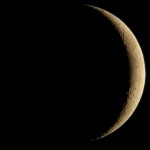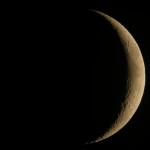Here are two images of the Day Three moon, one from Wednesday night, and one from a month ago. Apart from the technical differences of exposure, and a slight misalignment (the “horns” of the moon aren’t exactly parallel, but that’s just an artifact of my inability to rotate them to the exact same angle, not a difference in the moon itself), what differences do you see? What’s responsible for them?
Tentative answers after the “read more” link…
The shot from January 18 (6:48 p.m. EST) shows a moon aged 3 days, 16 hours, 35 minutes; the shot from February 17 (7:34 p.m. EST) shows a moon aged 3 days, 21 hours, 40 minutes. So even though the photos were taken only “47 minutes apart,” the moon is actually 5 hours and 6 minutes farther into its cycle in the second shot than in the first one.
The moon’s age (that is, the time since the moment of new moon; not the age since the creation of the moon, although in many–all?–native traditions, the moon is created anew each month) is important for a couple of reasons. In the first place, it illustrates the fact that the rhythms of the two bodies (well, three, actually, since we have to include the Sun) aren’t the same. In the second place, it’s what accounts for the (slightly) different location of the terminator between the two views.
The quick explanation for these differences is that sunrise on Earth and sunrise on the moon are based on similar, but unrelated, events. Sunrise on Earth occurs every “24” hours, based on our planetary rotation. Similarly, sunrise on the moon occurs every “29.5” days, based on its own rotation. (Yes, even though the moon always shows the same face to Earth, it still rotates on its axis. If it DIDN’T rotate, it couldn’t show us the same face, since it also revolves around us, and therefore “our” side of the moon would be on the other side of the moon half the time!)*
But the fact that these two events occur at even close to the same time from month to month is a result of the moon’s synchronous rotation (it completes one rotation on its axis in the same time it takes to complete one revolution around the Earth [technically, around the barycenter of the Earth–Moon system]). But because the synodic period of the moon is 29.5 days, sunrise on the moon doesn’t occur at the same Earth time from month to month; it’s always off, according to our Earthly clocks.
But you don’t need to know all that just to enjoy pictures of the Moon!
*I put the times in this paragraphs in quotes because they’re nominal, not actual. Earth rotates on its axis every 23 hours and 56 minutes, but we call it 24 hours, sort of like we say that a piece of wood measuring 1.5 inches by 3.5 inches is a 2×4. Similarly, the moon revolves around Earth every “29.5” days; we used to call that a “month,” but now we base our calendar on Earth’s revolution around the Sun, rather than the moon’s revolution around Earth. So a “moonth” and a month are no longer the same thing, except in the calendars used by a few billion people around the world (e.g., China, practitioners of Islam, Judaism, and probably dozens of other cultures of which I am ignorant).



